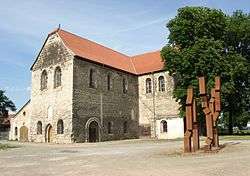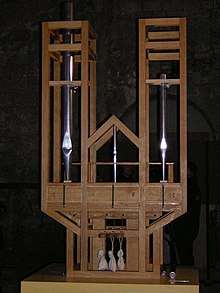As Slow as Possible
Organ2/ASLSP (As Slow as Possible) is a musical piece by John Cage and the subject of one of the longest-lasting musical performances yet undertaken. It was originally written in 1987 for organ and is adapted from the earlier work ASLSP 1985; a typical performance of the piano version lasts 20 to 70 minutes.[1] In 1985, Cage opted to omit the detail of exactly how slowly the piece should be played.

The performance of the organ version at St. Burchardi church in Halberstadt, Germany began in 2001 and is scheduled to have a duration of 639 years, ending in 2640.
History
The piece was commissioned for a piano competition by The Friends of the Maryland Summer Institute for the Creative and Performing Arts as a contemporary requirement. Cage employed an open format mainly to ensure that no two performances would be the same, providing the judges a break from the monotony of most compositions. The score consists of eight pages.
Performances
On February 5, 2009, Diane Luchese performed "Organ²/ASLSP" from 8:45 a.m. to 11:41 p.m. in the Harold J. Kaplan Concert Hall at Towson University. This 14-hour-and-56-minute performance, in strict adherence to the score's temporal proportions, is the longest documented performance of the piece by a single person so far,[2] although a full 24-hour performance of the original piece, ASLSP, was given by Joe Drew during the ARTSaha! festival in 2008. Drew has also given 9- and 12-hour performances of the piece, and as of September 2018, was planning a 48-hour performance.[3]
On September 5, 2012, as part of John Cage Day at the University of Adelaide, Australia, Stephen Whittington performed an 8-hour version of ASLSP on the Elder Hall organ. The eight sections of the work were each allocated an hour, with each section divided into segments of one minute, within which the precise timing of events was left open. In performance, seven sections were performed, with one omitted and one repeated. Organ registrations were determined by chance procedures.[4][5][6][7]
A 12-hour performance took place on September 4–5, 2015, in an all-night concert at Christ Church Cathedral in Montréal, Québec. The work was performed by the Cathedral organists Patrick Wedd, Adrian Foster, and Alex Ross, while other Cage compositions were performed simultaneously in the church. The performers used a stopwatch, and the timing of each note was precisely calculated and written into the score.
On June 22, 2019, to mark "the shortest day" (Southern Hemisphere Winter solstice), organist Daniel Cooper presented a 12-hour performance of Organ²/ASLSP in Knox Church, Christchurch, New Zealand (first New Zealand Performance). The performance began at 10am and ended at 10pm.[8]
Halberstadt performance


Background
A 1997 conference of musicians and philosophers discussed the implications of Cage's instruction to play the piece "as slow as possible", given that an organ imposes virtually no time limits. A project emerged to perform the piece for 639 years. A properly maintained pipe organ has no specific lifespan; the duration was chosen to commemorate the first documented permanent organ installation, in 1361 in the Halberstadt Cathedral, 639 years before the proposed start date of 2000.[9]
The instrument
An organ was built specifically for the performance in 2001 and by 2009 6 pipes were installed.[10] It stands in the right transept of the Burchardi Church, with the bellows in the left. Between January and May 2005, it contained only six pipes. Because the instrument sounds constantly, there is a cube of acrylic glass encasing it to reduce the volume. [11]
Performance
The performance commenced in the St. Burchardi church on September 5, 2001, with a pause lasting until February 5, 2003. The first chord was then played until July 5, 2005. The chord consisting of A above middle C, C above middle C and the F♯ above that (A4-C5-F♯5, an F♯dim chord in first inversion) began sounding on January 5, 2006, and concluded on July 5, 2008. That sonority can be heard on a website devoted to the Halberstadt event.[12][13] To do a long play time sandbags are used on the organ pedals to keep the piece playing. On July 5, 2008, the weights holding down the organ pedals were shifted resulting in the 6th chord change.[1] Two more organ pipes were added alongside the four already installed and the tone became more complex at 15:33 local time. The bellows provide a constant supply of air to keep the pipes playing.[14] On July 5, 2012 two more organ pipes were taken out. And 2 were in the organ. The most recent note change occurred on October 5, 2013, [15] and the next change will not occur until September 5, 2020. The performance is scheduled to end on September 5, 2640.
Sound changes
The piece started with a 17-month rest on September 5, 2001, which would have been Cage's 89th birthday. The first sound appeared on February 5, 2003. Subsequent dates for note changes include:
- K(lang) = Sound beginning
- P(ause) = Sound ending (rest)
|
|
See also
- List of compositions by John Cage
- AS Long As Possible, a GIF-based visual art work named in tribute to As Slow As Possible
- Clock of the Long Now
- Longplayer
References
- 'World's longest concert' resumes, Steve Rosenberg, BBC News (2008-07-05). Accessed 2008-07-05.
- "The Towerlight, Fifteen hours at the organ". Media.www.thetowerlight.com. Archived from the original on 2009-02-10. Retrieved 2011-08-30.
- "Joe Drew's Bio". Analogarts.org. Retrieved 2011-08-30.
- "Stephen Whittington: Musical Renewal". RealTime. Retrieved 2012-09-27.
- "News and Events". J.M. Coetzee Centre for Creative Practice. Retrieved 2012-09-27.
- "John Cage Day, Wednesday 5th September 2012". Retrieved 2012-09-27.
- "John Cage Day Celebrated in Adelaide with Free Concert in Elder Hall". Herald Sun Newspaper. Retrieved 2012-09-27.
- "John Cage: Organ2 / ASLSP". Music Canterbury. Retrieved 2019-07-07.
- First notes for 639-year composition, BBC News (2003-02-05). Accessed 2008-07-05.
- "Sankt Burchardi Church Organ". atlasobscura.com. Retrieved 2018-12-20.
- https://www.youtube.com/watch?v=FaABvYVfiuA
- "News - John-Cage-Orgelprojekt Halberstadt". www.aslsp.org. Retrieved 2019-12-08.
- "the Halberstadt event website". John-cage.halberstadt.de. 2004-11-19. Archived from the original on 2011-07-22. Retrieved 2011-08-30.
- "One Thousand Hear Change of Note in World's Longest Concert". Deutsche Welle. Deutsche Presse-Agentur. 2008-07-05. Retrieved 2011-08-30.
- https://www.youtube.com/watch?v=vl_s6yF4pKs
- "Klangwechsel - John-Cage-Orgelprojekt Halberstadt". www.aslsp.org. Retrieved 2019-12-08.
- "Klangwechsel bei Cage-Aufführung in Halberstadt: Das langsamste Orgelkonzert der Welt". Spiegel Online. 2013-10-05. Retrieved 2019-12-08.
External links
- Website of the Halberstadt event (in German)
- As Slow As Possible, Performance Today feature (National Public Radio), September 2003
- Recordings of a nine-hour performance of ASLSP at ARTSaha! 2006 by Joseph Drew: Hour One, Hour Six, Hour Nine
- (in German) Die eingefrorene Zeit, Die Zeit, January 8, 2006
- Website of the documentary film 'ASAP' by Scott Smith
- World's longest concert will last 639 years The Washington Post. November 21, 2011.